Set Review ➟ 80058 LEGO® Monkie Kid™ Celestial Pagoda
“It’s much smaller than I expected.”

That was the first comment from my son upon seeing the partially completed model. The reason we have a son is because my wife did not say that to me a couple decades earlier. Anyway. I had the same initial reaction as my son. Somehow the box gave the impression that this model would be bigger. Looking at the complete model and comparing it to the box it definitely seems bigger than what is on the box, yet by itself it still seems…small?
The pagoda measures about 62cm/24.25in tall. That’s 6cm taller than Megapolis City. Being fair about it, though, Megapolis city has 15cm of spire and the pagoda’s is less than half that. The pagoda’s spiritual cousin is the Heavenly Realms model, and that is about 38cm tall. But what the pagoda has in height it definitely lacks in width and depth at a mere 27cm wide by 17cm deep. When actually placed next to Heavenly Realms, though, suddenly it seems less small.
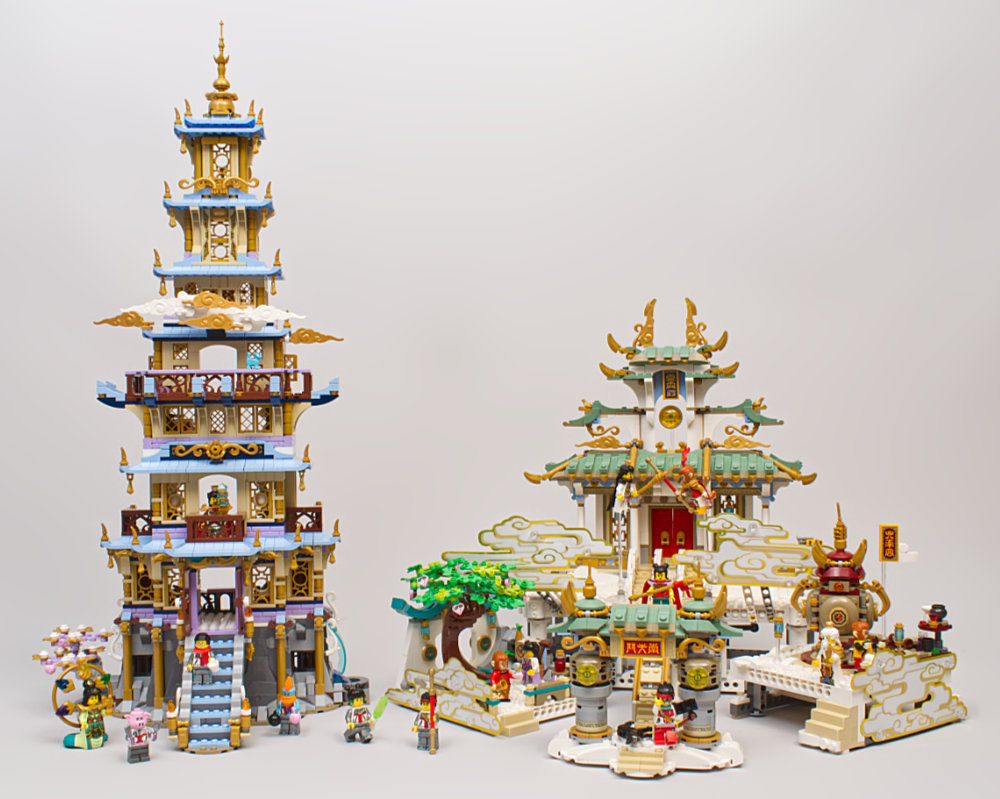
The other thing about the Celestial Pagoda is that it appears serene. It has a calm light color scheme which is definitely in contrast to the vivid chromatic chaos usually found in Monkie Kid sets. And the Pagoda doesn’t do anything. Aside from a few windows and doors, one being a trap door, there are no moving parts or secrets or surprises. It just sits there, serene.
The build is also fairly serene. It is for the most part just stacking. There are few points of assembly where something is attached sideways…and that is mostly doorknobs, clips, and some bars into hollow studs. There are also a few instances of pins through technic bricks and a couple brackets, but that’s basically it. The absence of everywhichway assembly makes for a pretty solid build and I did not find parts wanting to come off anywhere on the model while doing the photography for the review. In my experience parts not coming off unintentionally is a rare occurrence with these larger models.
LEGO advertises the model as being sectional, which it is, but when broken into separate modules the sections are not reconfigurable. As the sections can’t attach to one another in any other way than the original stacking order, this kind of results in a “meh, so what” experience.
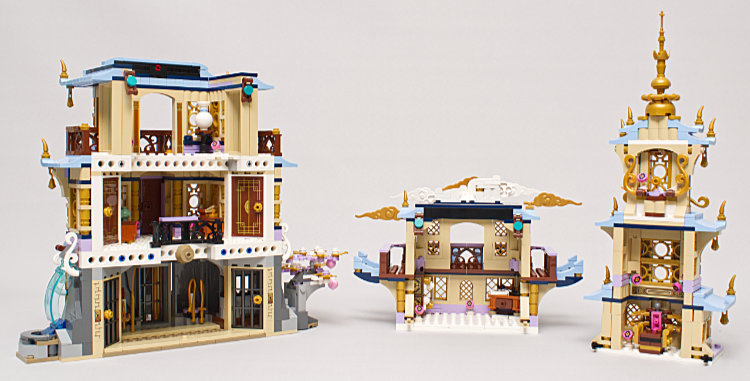
The sections when stacked have the additional security of being attached with clips and bars. Often the modular “removable” sections on LEGO buildings are held in place by only a few studs. With this model the top-to-center section connection uses some studs and the clips while the center-to-lower section connection doesn’t even have any studs. Surprisingly the whole model can be lifted by the center section when all sections are attached.
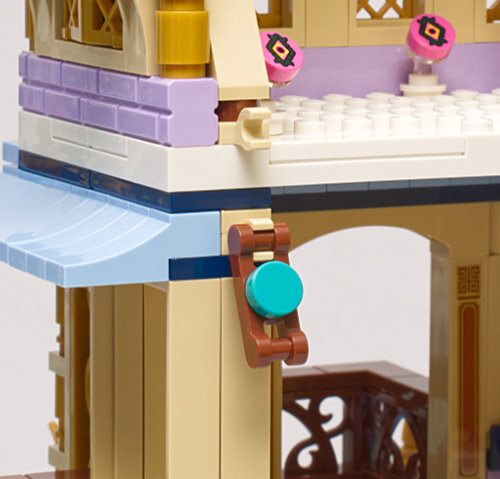
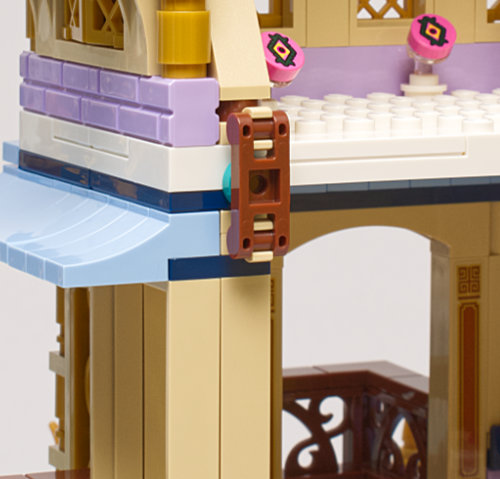
Let’s take a tour of the six floors of the Celestial Pagoda from the top down. The top floor has no floor space and is filled with a small table with some ornate side decoration, topped with a mount and one of 100-Eyed Demon’s remote eyes. Those eyes will appear all over the interior of the Pagoda. The back of the box suggests that the yellow stone gets attached to the mount.
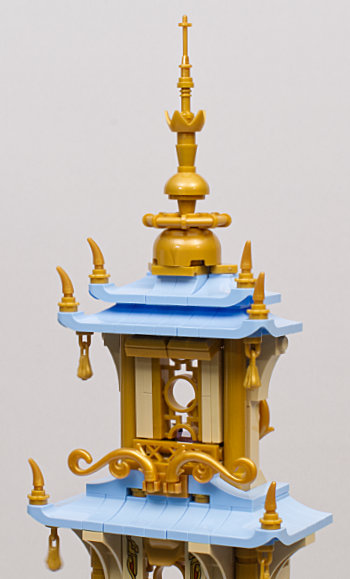
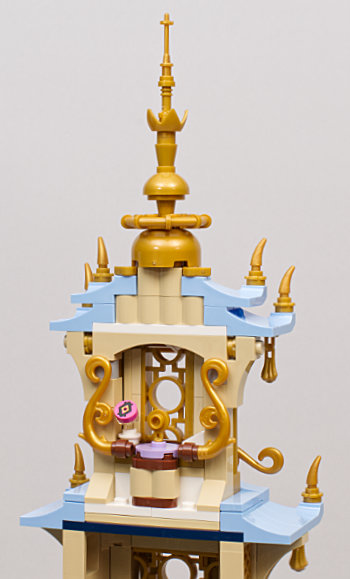

On the fifth floor sits a throne surrounded by demon eyes. This throne is crafted from the same parts that make up a section of 100-Eyed Demon’s centipede creature from the Team Power Truck set. Interesting to note that the throne by itself stands up no better than does the creature.
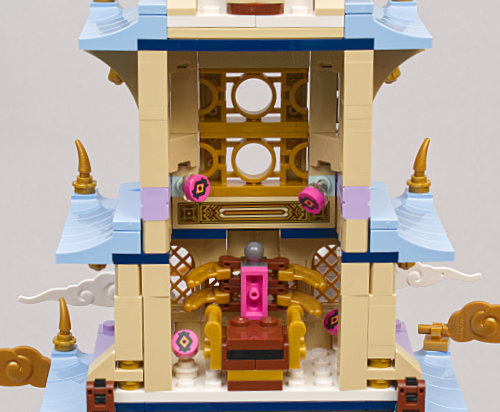
Interior
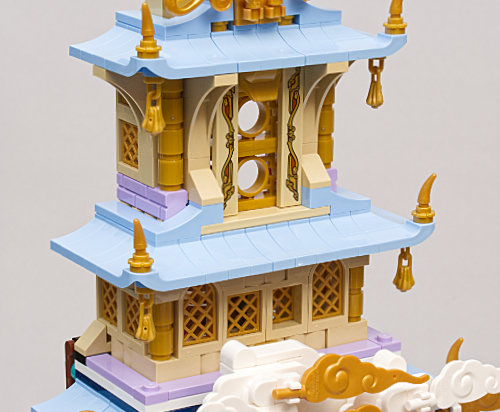
Exterior

The throne surrounded by demon eyes.
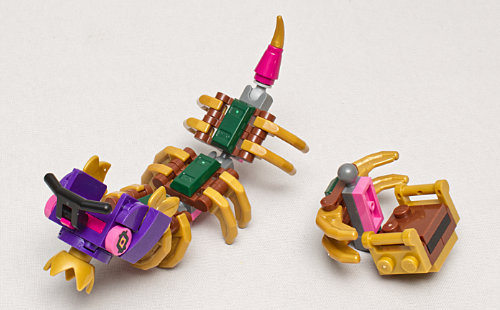
Yup. Definitely related.
The fourth floor appears to be a library of sorts. The left side of the room has scrolls loosely stored in a rack; the right side has a desk atop which is a page and an ink brush. No seat is to be found, nor is much else except for the requisite demon eyes. Oddly there is a wraparound exterior balcony which is above head level with no obvious means of access. I guess characters either fly or have to jump through a closed window above their heads to get onto the balcony. The balcony makes visual sense from the exterior but no practical sense from the interior.


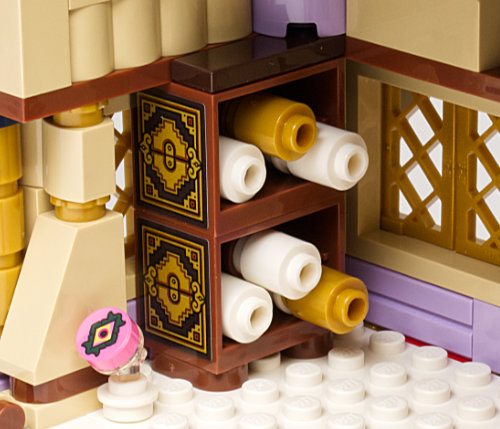
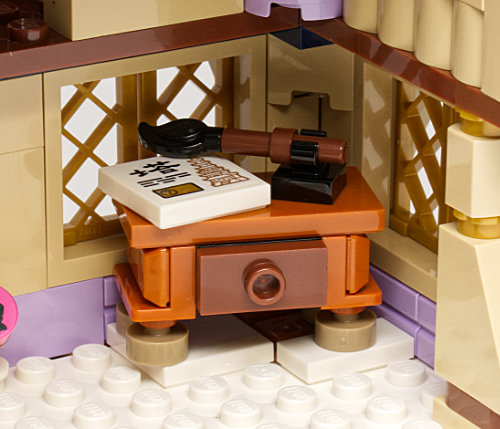
The third floor exterior has three small balconies, all accessible via open doorways. The interior boasts an inexplicable door in the floor, a couple pieces of decorative porcelain and, of course, demon eyes.
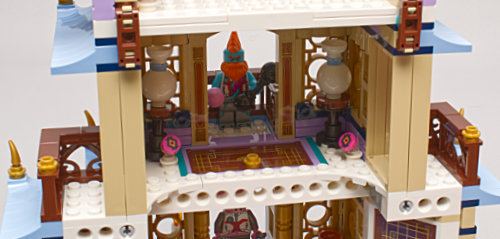
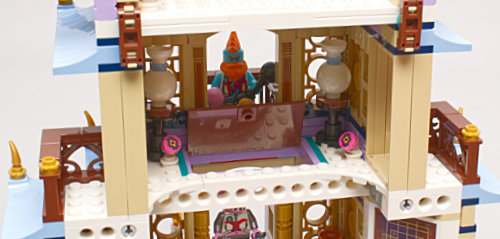
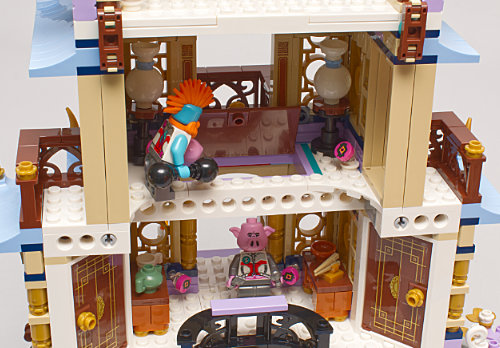
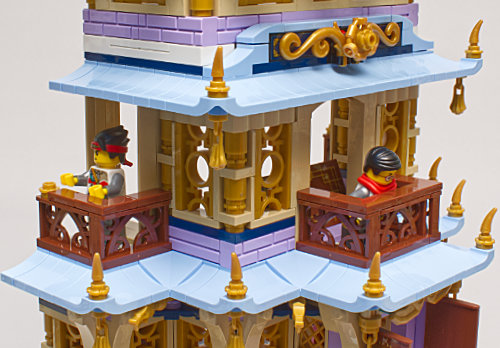
The second floor sits at the top of the exterior stairs and it looks like some eating takes place in the room. Doors in the room include a central entrance double-door opening onto the stairs and a door on either side of the room. Opposite the central doors and between the side doors there is a black railing with demon eyes around a cutout in the floor. The railing proves to be an obstacle when it comes to placing figures behind it. The door on the sides of the room open to reveal tapestries. There was a design trade-off when designers decided the doors should open towards the inside of the room and not to the outside. When open, the doors block the path around the railing and a figure cannot stand in the available space to open the door. If the doors opened the opposite way then access to whatever is behind the door is limited as the doors open only 90 degrees…so open door and not be able to see into room. This begs the question as to why doors are included here at all.
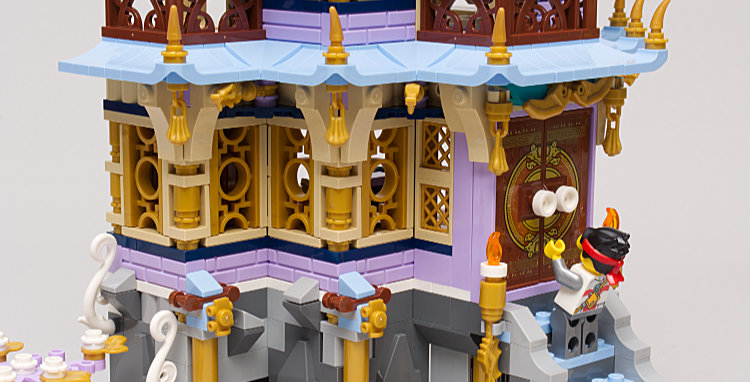


The railing obscures a trap door in the center of the floor. The trap door is operated by pulling a pin in the floor and unsuspecting characters fall into the first floor dungeon.
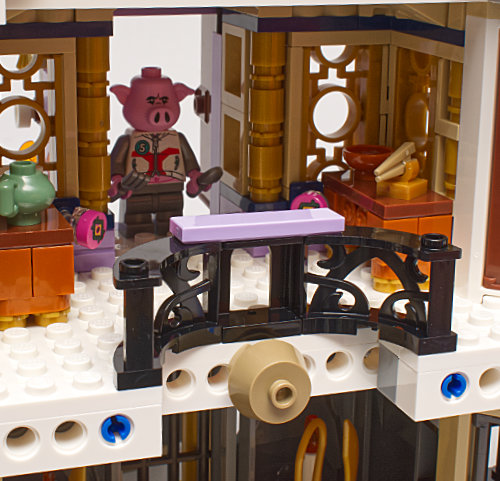
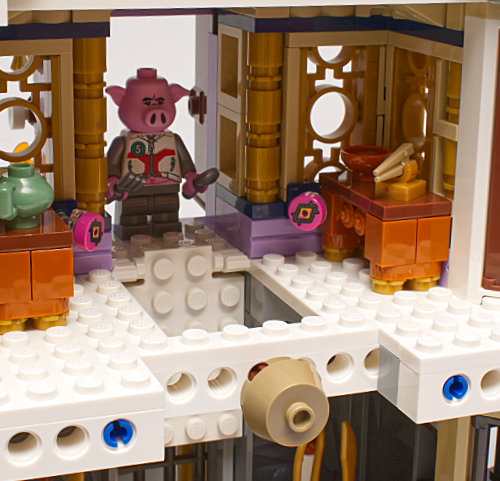
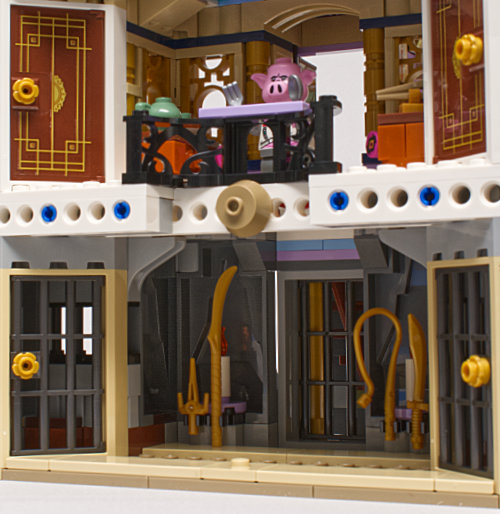

The first floor is a dungeon with non-opening bars in the far center of the room looking out onto the underside of the stairs. Echoing the design of the floor directly above, there are doors, this time barred doors, on either side of the room. A tiny cell is behind each door, triangular in shape, with just enough room to accommodate a minifigure either standing up or precariously perched on a small seat.

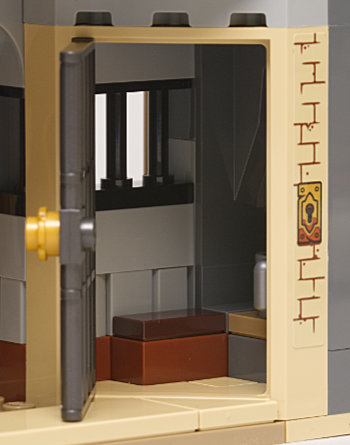

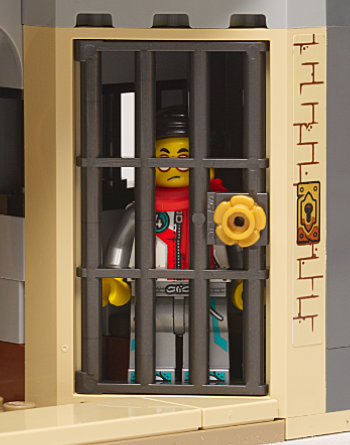
The exterior features some central stairs and a small removable module on either side. One side has a tree and the other a basin under a small waterfall. I don’t know from where this blue water originates, but I guess I should be thankful that the water is blue and not yellow.
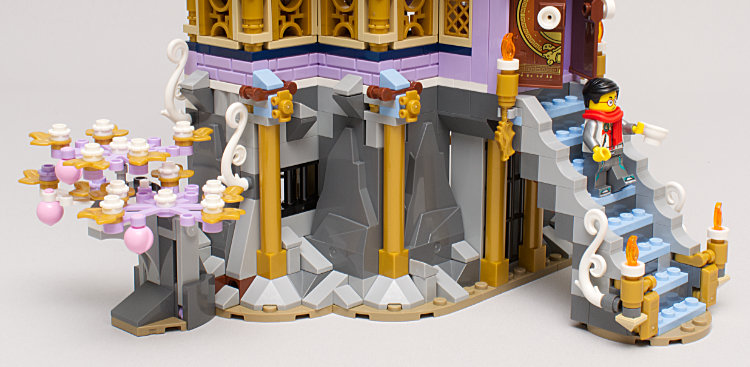

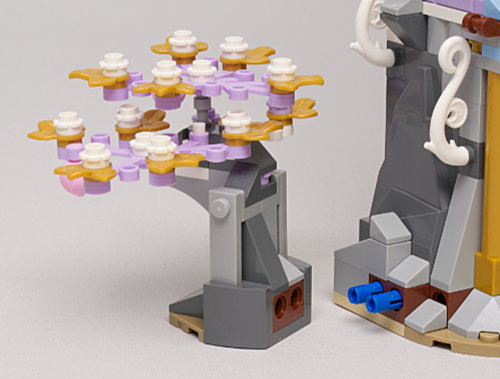
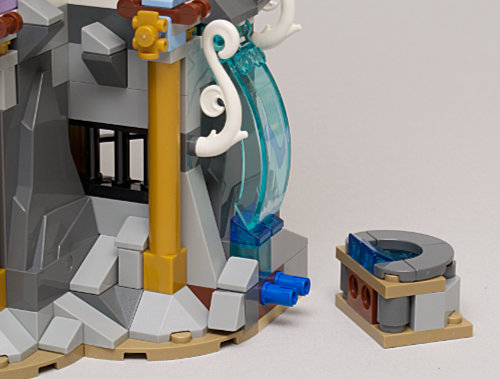
Technic pin-and-hole connectors should allow for the model to be attached to other sets but some care or modification may be necessary to achieve a good connection. I attempted to attach the temple to set 80036 City of Lanterns, but the waterfall on the temple extended a little too far out and interfered with steps on the City, preventing a secure connection. Farther up on the sets other pieces also required some pivot or other adjustment. Your mileage may vary depending on your companion set.


The set’s serenity even extends in some part to the MK Team minifigures in coordinated outfits. While there are minor differences in the torsos—the significant difference lies with a distinct number for each character: MK is 1, Mei is 2, Monkey King is 3 (he is missing from this set but available in the Nine-Headed Beast set), Mr. Tang is 4, Pigsy is 5, and Sandy is 6. These figures have legs that are in common except for Pigsy whose legs are medium size and dark bluish gray and not flat silver like the others. The team’s head and hair pieces have been seen before.
New characters: Li Jing has new designs for torso, legs, and head. The cape is in a new color and his hair and shoulder armor have been seen before. He holds a small magical pagoda that allows him to keep his son, Nezha, in line. Sort of. Says mythology (yay wikipedia!).
Nüwa is a creator goddess who, according to mythology fixed the world with five colored stones. In this figure she carries the stones on a sort of back-mounted halo attached to previously seen shoulder armor part 86123. She is also carrying a small gold statuette…I don’t know what that’s all about. Nüwa has a new print on her torso, new parts include her dual-molded tail, part 21545, and hair, part 5266. Her head was previously used on the gem store owner in Megapolis City.
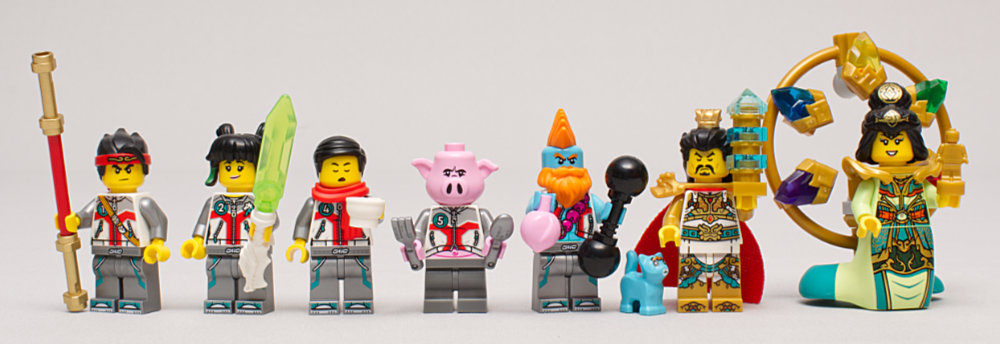
Monkie Kid, Mei, Mr. Tang, Pigsy, Sandy, Baby Mo, Li Jing, and Nüwa


The Randolph T. Fielding Absolutely Administrivia Section
The set has two sheets of stickers, one on a transparent carrier and the other on white.
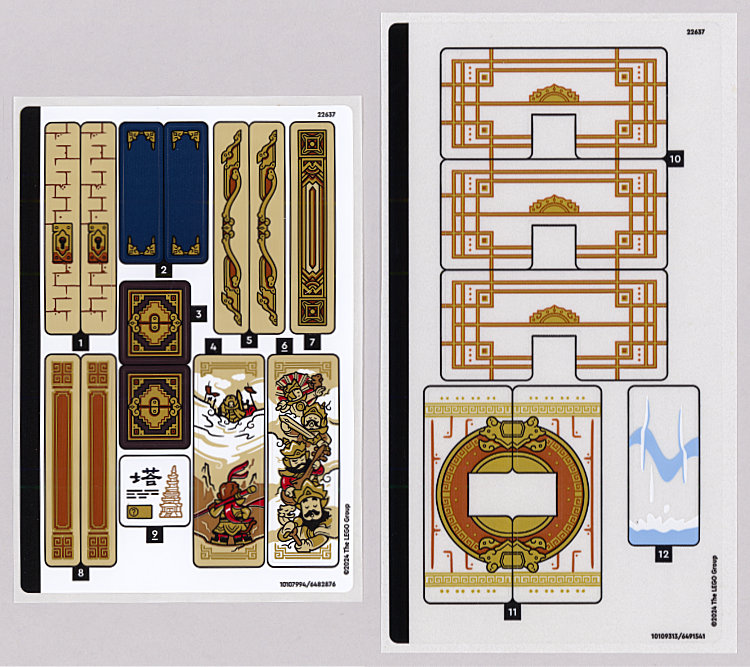
Old parts in new colors include 73682 and 99301 in bright light blue.

Parts 73682 and 99301.
Newer pieces also seen in other Monkie Kid sets in the Summer 2024 wave are the 1x1 round tile demon eye print on dark pink and the 5518 piece in white.
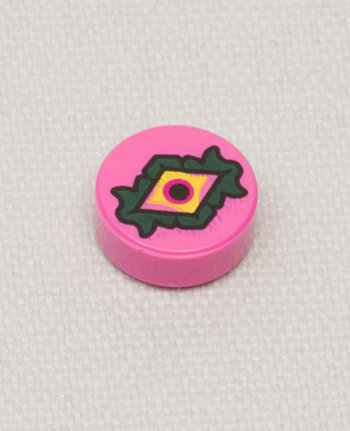
Demon Eye print.
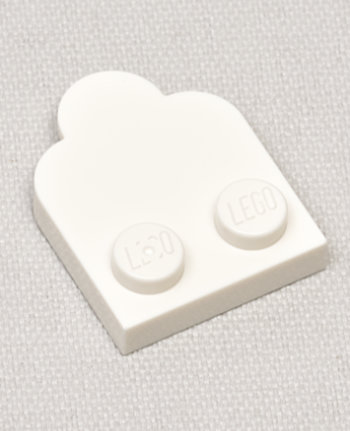
Part 5518.
This is possibly the only set with all five colored stones and possibly the only set containing the yellow stone, at least so far.

Nüwa’s lower part is dual molded in bright light green and turquoise. It is slightly rounded on the front side which prevents the piece from setting flush against another brick. The front part of the piece nests onto studs in the typical way with the tail raised at the butt to avoid studs and lowering at the end to grab a stud.
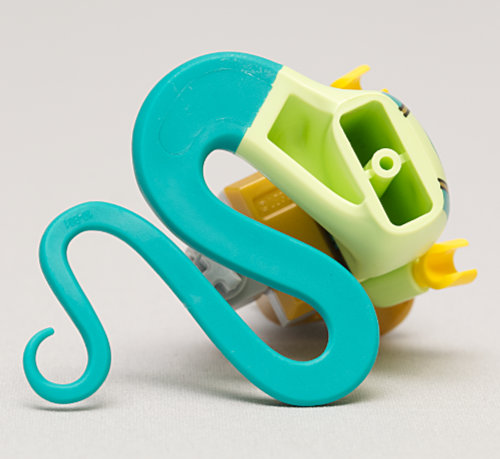
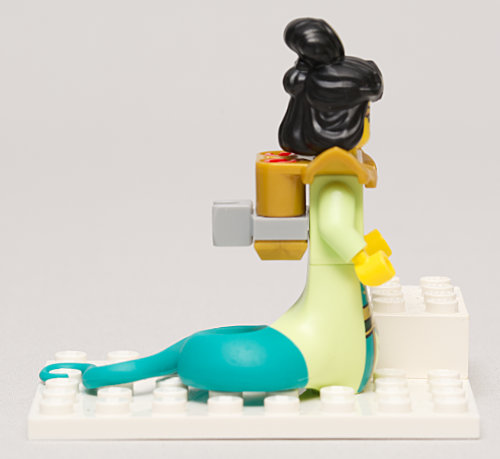
Summary
Exuding an aesthetic of tranquility and harmony not often found in Monkie Kid sets, this is an attractive and very tall model. Although the set has a modular aspect to the assembly the modules are separable but not reconfigurable. Interactive elements are at a minimum consisting only of windows and doors. If you are looking for a contemplative temple as a display piece with a solid build that is relatively free of SNOT and other assembly techniques, this fits the bill. I would not rate play value particularly high with this model as placing figures into rooms can be problematic in terms of the size of the rooms and access being tricky or limited. The exterior is wow in a good way; the interior is also wow but in not such a good way.
Disclaimer
Thanks to LEGO for kindly providing the set for review.
33640